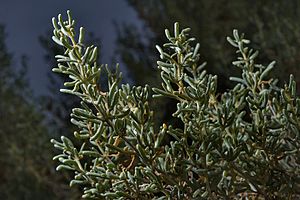Seidlitzia rosmarinus facts for kids
Quick facts for kids Seidlitzia rosmarinus |
|
|---|---|
 |
|
| Scientific classification | |
| Genus: |
Seidlitzia
|
| Species: |
rosmarinus
|
| Synonyms | |
|
|
Seidlitzia rosmarinus is a green desert plant. It is a type of saltwort and belongs to the Amaranthaceae family. You can find this plant in the lower Jordan Valley near the Dead Sea. It also grows in Israel, Jordan, the Syrian desert, and parts of Iraq. You can also see it along the coasts of Saudi Arabia, on the islands of Bahrain, Qatar, and in Iran. People often call it ʾušnān or šenān in Arabic. In some other languages, it is known as ʾuḥlā.
This plant is very useful! Bedouins, who are people living in the desert, often use it for cleaning. It can be used as a substitute for soap. Long ago, people also used it to make a special soap called Nabulsi soap. They even used it in medicines. For example, it was used to help treat scorpion stings. It was also a way to get potassium for other health uses.
Where Seidlitzia rosmarinus Lives
This plant mostly grows in flat, salty areas called sabkha. It likes hard soil surfaces. You can also find it growing along dry riverbeds, known as wadis. It thrives in places where the soil is salty and alkaline. Because of this, its leaves collect a lot of sodium and chloride (salt).
Seidlitzia rosmarinus loves silty soil. This soil can be very slippery when wet. But when it dries, it becomes very hard. It can even break into fine dust. You might often see this plant growing on small hills, called hummocks, in these types of areas.
What Seidlitzia rosmarinus Looks Like
S. rosmarinus has thick, fleshy leaves that grow in pairs. It also has special wing-like parts on its flowers. These wings grow above the middle of the flower's parts, called the perianth.
One special thing about this plant is how its leaves connect. Their bases are almost completely joined together at the stem. There is no long channel running down the stem between the leaves. Each leaf also has a small, dense bunch of white hairs where it meets the stem. This area is called the axil.
The wings and other parts of the flower are not all the same size. The wings of the plant overlap each other. The upper part of the flower's perianth is wide at its base. This plant is known as a xerophyte. This means it has special ways to live in places with very little water. It usually blooms in late March, April, and early May.
Ancient Uses of Seidlitzia rosmarinus
For a very long time, people have used Seidlitzia rosmarinus to make potash. This is why it has the Arabic name ušnān. In the 10th century, an Arab doctor named al-Tamimi wrote about this plant. He said it was brought to places like Palestine and Egypt from areas around Amman in Transjordan. People used it to make a type of alkali soap called ġāsūl and other cleaning products.

Al-Tamimi explained how they made these cleaning agents. They would gather the fresh, green plants in big bundles. Then, they put them into special furnaces. These furnaces had plastered floors and stone spouts. Large pieces of wood were burned under the plants. This heat caused the melted alkali substance to drip out of the spouts. It would collect on a flat area below. This liquid would cool down and become hard. The final product looked like a hard, black stone. People could break this stone into smaller pieces. They then used these pieces as a laundry detergent.
Some types of these salt bushes also produced a brownish substance. This substance was a kind of potassium alum. It was very strong and had a burning taste. Al-Tamimi also said that when you burn the green leaves of Seidlitzia, you get a substance called al-qalī. This is a natural cleaning agent. The "plant ashes" (potash) from this process could be turned into potassium. To do this, they put the ashes in a pot, added water, and heated it until the water evaporated, leaving the potassium.
This plant was also believed to help with bad breath, known as halitosis. People would apply a small amount of the prepared substance to their gums. It was said to have a strong, unpleasant feeling because it was so strong. After about an hour, they would rinse their mouth with cold water. Then, they would gargle with Persian rose oil to cool their mouth.

